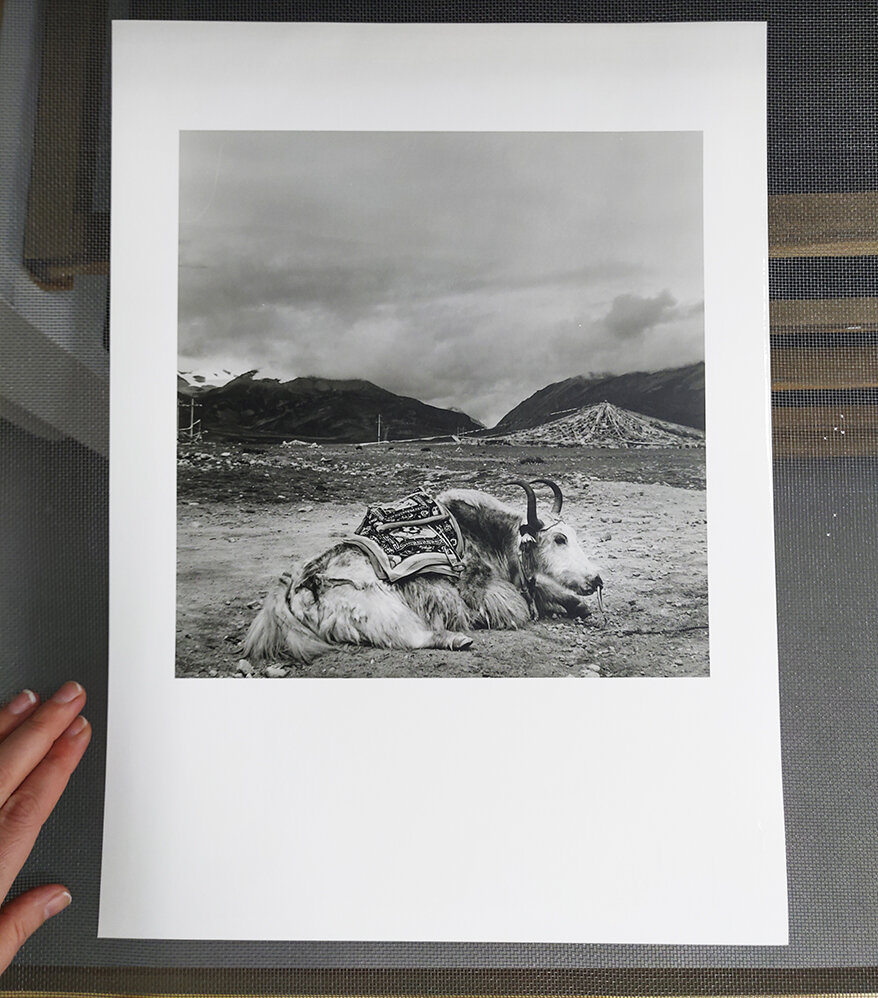Silver gelatin photograph – what is it?
Silver gelatin photograph or gelatin silver photograph is a black and white photograph, which is usually made by hand in the darkroom using gelatin silver technique. Gelatin silver technique was born in the 1870’s and it has stayed very much the same to the present day.
Gelatin silver photograph may refer to one of two things: either the film negative or the gelatin silver print made of this negative. The technique has gotten its name from the fact that both the film and photographic paper used in the technique contain small silver particles, bound in a gelatin layer. During the exposure the particles get darkened by the light, and after certain chemical baths the latent image becomes visible on the film or on the photographic paper.
The photograph, which is made in the darkroom using this technique is called a gelatin silver print. It is often made from a film negative, but gelatin silver prints may be produced also without camera, for instance using the photogram technique. In photograms, the objects placed on the light sensitive photographic paper leave their shadows in the picture. Next I will outline roughly the gelatin silver printing process. This explanation is written to give the general idea of the process, and don’t go in it on a detailed level. Those will follow too to interested readers later on!
On the left the enlarger, used to expose the photographic, light sensitive paper. On the right, the darkroom chemicals in their trays.
Gelatin silver print workflow
The process of making gelatin silver prints includes many different phases, of which the most common ones are these:
First you choose the negative, of which you want to print the photograph. You put the negative in the enlarger machine in the negative carrier. Then with the enlarger you give light through the negative for the light sensitive paper. The photographic papers are special papers treated so that they are not sensitive to most red and orange wavelengths of light, but instead the green and blue ones. That’s why they may be taken out in the red light of the darkroom, but they get exposed by the sunlight or by the light of the enlarger, which is usually common halogen or led light.
After exposing the paper you soak it first in the developer, then in stop and then in fix – three chemical baths, which first make the image appear on the paper, then stop the developing process and remove the residue of the developer, and then fix the image by removing the unexposed silver from the paper. After the chemical baths the print needs to be washed properly, sometimes in several stages. Also washing aid chemicals may be used to boost the rinsing. If the print hasn’t been rinsed well, the residue of the chemicals stay in the paper and start to react with each other and the surrounding environment, finally ruining the print.
After the washings the print may be treated more. Some parts of the print may be brightened by a chemical compound referred often to as Farmer’s Reducer or the print may be toned with photographic or other toners. After these treatments the print must be washed again. After rinsing the print is placed to dry on a drying screen. Some prints need heat pressing so they don’t get curvy.
Spotting colours with small brushes.
Small dust particles on the negative leave small white marks on the ready print. Those white marks are spotted away by a small brush and spotting colours.
Art of the Gelatin Silver Print
In the fine art printing tradition in which I work, made famous by artists as Ansel Adams, Imogen Cunningham or Paul Strand, the aim in making the gelatin silver print is to make a photograph, where can be found deep dark and bright white tones, and preferably wide range of different subtle grey tones in between. The darkest parts are not “stuck” but there are different shades too, and the bright parts are not completely blown out. However gelatin silver printing offers a huge variety of different possibilities and instead of the wide tonal range you may head for the grainy look (very much in fashion after the digital revolution) or dramatic contrasts. The beauty of the gelatin silver technique is that you may find within the same technique an amazing variation of styles, looks and unique artistic visions – all made by hand, meticulously one by one.
A gelatin silver print made and stored well may preserve, as history has proven, well over hundred years, and when made by today’s archival standards, probably way more than that. Apart from that, in a well executed gelatin silver print may be seen a special luster, coming from the real silver particles, which distinguishes it from machine made prints, like the pigment inkjet printed photographs. You may read more about the differences between different photographic printing techniques from here.
Ready gelatin silver print drying
Do you need more information about gelatin silver photography?
Gelatin silver printing technique is a unique form of darkroom art and handmade photography practice. It has become rare because of the digital photography and machine based photography printing possibilities. Especially in Finland the knowhow of gelatin silver technique among the professional artist photographers was near to disappear completely. In 2016 I founded with five other photographic artists Finnish Darkroom Association, which promotes, teaches and cultivates the handmade darkroom photography in Finland. The association works actively in the field and cooperates with other institutions. English webpage is coming soon here.
If you wish to know more about the gelatin silver printing process, you’re welcome to read the posts 5 Fist Steps to Succeed in Gelatin Silver Printing, and 5 Next Steps to Succeed in Gelatin Silver Printing. I will be writing soon more texts, so stay with me! Are there any other subjects, you’d like to hear about? Don’t hesitate to comments and I’ll gladly write.


